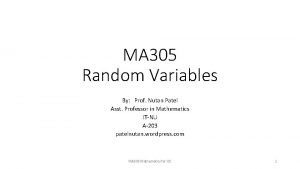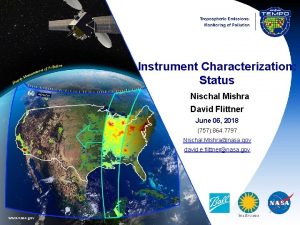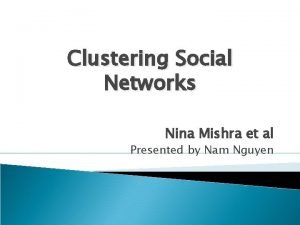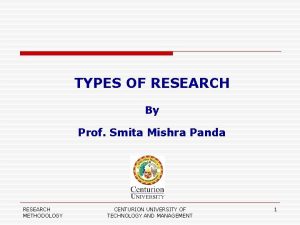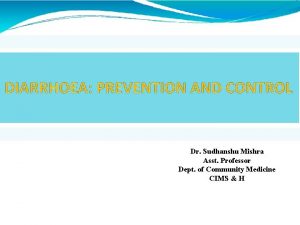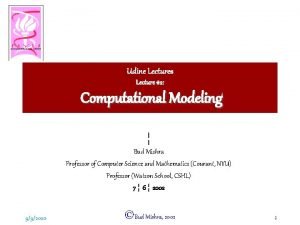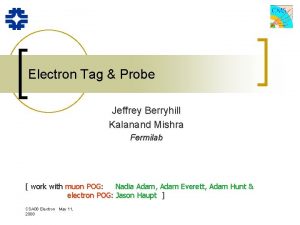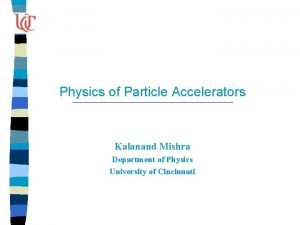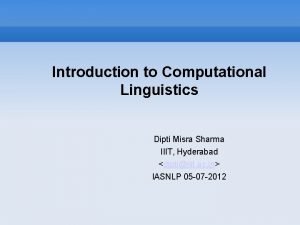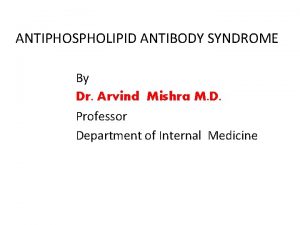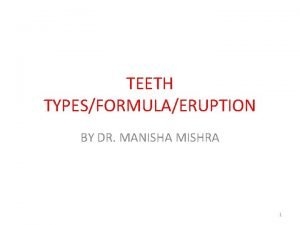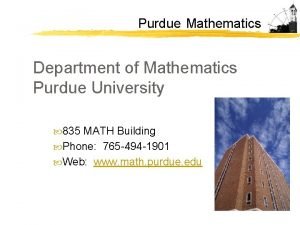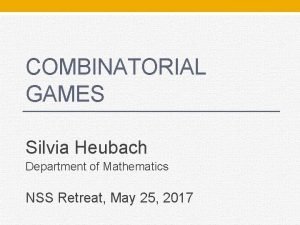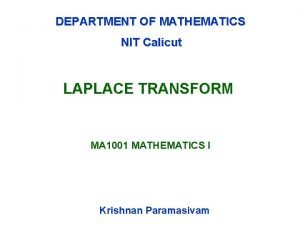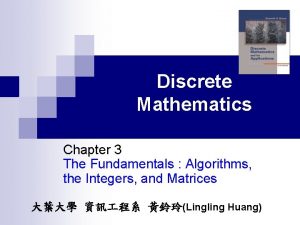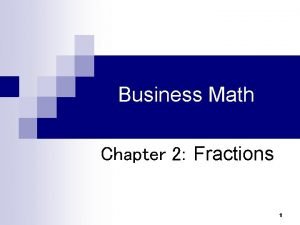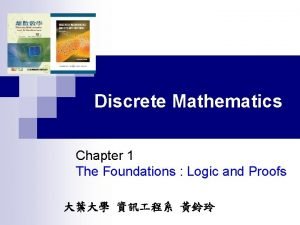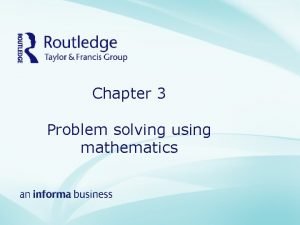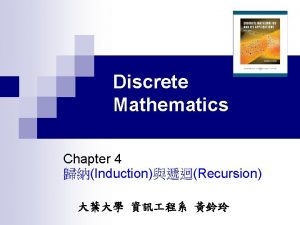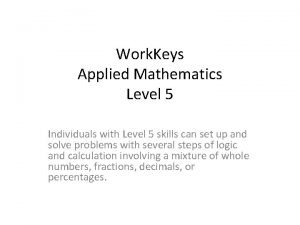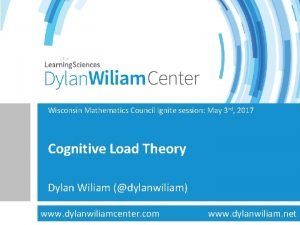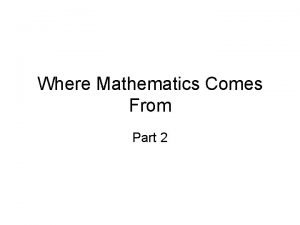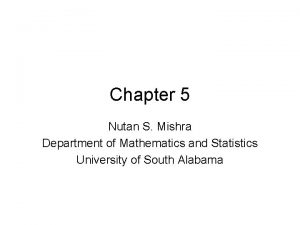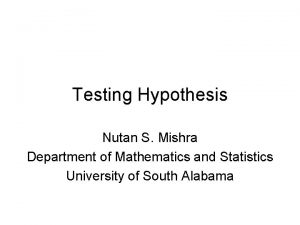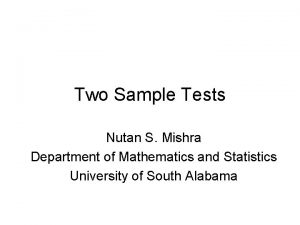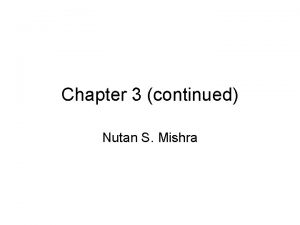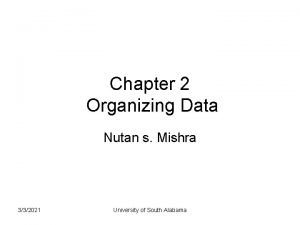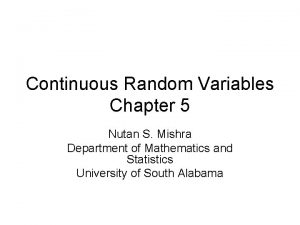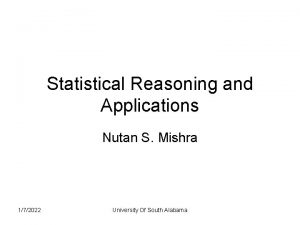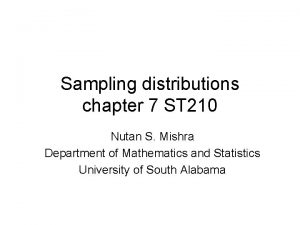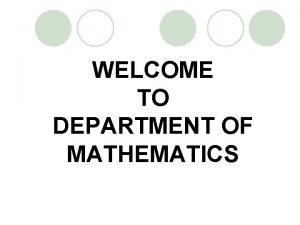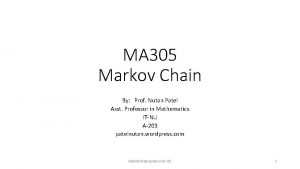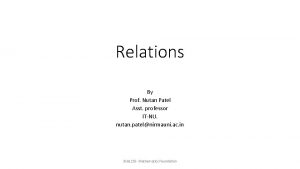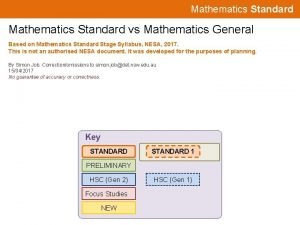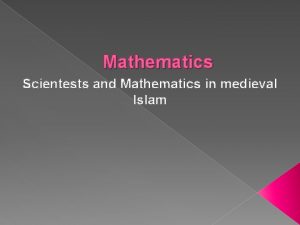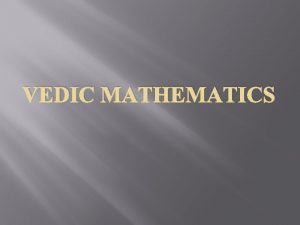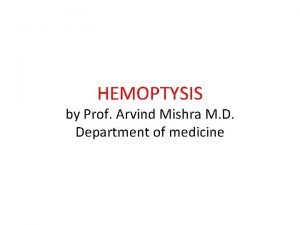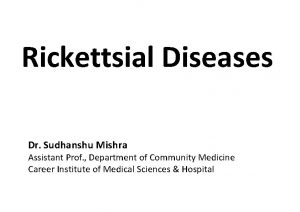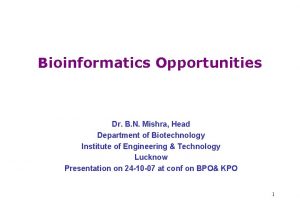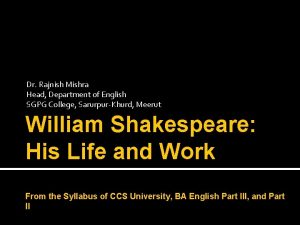Chapter 4 Nutan S Mishra Department of Mathematics




























- Slides: 28

Chapter 4 Nutan S. Mishra Department of Mathematics and Statistics University of South Alabama

Experiments outcomes and sample space An experiment is a process when performed results into a unique outcome out of several possible outcomes. For example when experiment consists of tossing a coin, there are two possible outcomes head and tail. When we perform this experiment, only one face will show up either head or tail. A sample space of an experiment is the set of all possible outcomes. We denote such a set by S Example: in the above experiment S = {H, T}

More examples Experiment: Roll a die S = { 1, 2, 3, 4, 5, 6} Experiment: Toss two coins S = { HH, HT, TH, TT} The first letter indicates outcome of first toss and second letter indicates outcome of second toss. Experiment: recording GPA of a student S = (0, 4)

An event is a collection of one or more outcomes of an experiment And event may be simple or compound Event is called simple event if it consists of only one final outcome of the experiment Event is called compound if it consists of more than one out comes of an experiment

Example of simple and compound events Experiment: toss two coins S = {HH, TT, HT, TH} Define event A = occurrence of two tails Then A = { TT} We say that A has taken place whenever TT shows up A is a simple event. Define event B = occurrence of one head Then B = { HT, TH} We say that B took place whenever either HT or TH shows up. Thus B is a compound event.

More Example Experiment : Roll a die S = { 1, 2, 3, 4, 5, 6} Define event A = occurrence of square number. Then A = {1, 4} A is a compound event Define event B = occurrence of an odd number Then B = { 1, 3, 5} B is a compound event.

Solution to 4. 2 a. One roll of a die S = {1, 2, 3, 4, 5, 6} b. Three tosses of a coin S = {HHH, HHT, HTH, THH, HTT, THT, TTH, TTT} c. One toss of a coin and one roll of a die S ={H 1, H 2, H 3, H 4, H 5, H 6, T 1, T 2, T 3, T 4, T 5, T 6}

Solution to 4. 3 • Experiment : drawing two items from the box containing three items • S = { AB, AC, BC}

Calculating probability of an event Probability is the likelihood of occurrence of an event. It’s the numerical measure of the likelihood that a specific event will occur. Notation: denote by Ei all the simple events and by A a compound event Denote by P(Ei) and P(A) corresponding probabilities. 1. Probability of an event always lies in the range 0 to 1 2. The sum of the probabilities of all simple event of an experiment is always 1.

Solution to 4. 4 , 4. 10 Denote a student by M type if suffers from math anxiety and type N if does not suffer from math anxiety. Experiment : selecting two students S = { MM, MN, NM, NN} 4. 10(a) event A = {MM} simple event 4. 10(b) event B = {MN, NM} compound event 4. 10(c) event C ={NM} simple event 4. 10(d) event D = {NN} simple event

Two properties of probability First property can be described as Example of first property : In tossing a coin P(H) =. 5, P(T) =. 5 Second property can be described as Example of second property: in tossing a coin P(H)+P(T) = 1

Example of two properties Experiment consists of rolling a fair die Then P(1) =1/6, P(2) = 1/6, P(3)=1/6, P(4) = 1/6, P(5)=1/6, P(6) = 1/6 P(1)+P(2)+P(3)+P(4)+P(5)+P(6) = 1

Classical probability Rule Two outcomes that have equal probability of occurrence are called equally like outcomes. Under the classical probability rule we assume that all outcomes of the experiment are equally likely. Example: tossing a coin, total number of outcomes =2. P(H ) = ½

Example: classical probability rule Experiment: rolling a die Define event E 1 as occurrence of a 6 E 1 = {6} P(E 1) = 1/total number of outcomes = 1/6 Define event A = occurrence of an even number A = { 2, 4, 6} P(A) = 3/6

Relative frequency approach If an experiment is repeated n times and an event A is observed f times, then according relative frequency concept of probability P(A) = f/n Example: At an assembly plant 500 cars are selected and 10 are found lemon Experiment : inspecting a car and declaring it lemon or good This experiment is repeated 500 times and lemon cars found ten times then P(lemon) = 10/500 and p(good) = 490/500

Note • Under classical approach the probability assigned to an event is exact probability • Under relative frequency approach the probability assigned to an event is approximate probability.

Law of large numbers If an experiment is repeated again and again, the probability of an event obtained by relative frequency approaches to exact (true) probability.

Solution to 4. 19, 4. 20 -. 55 can not be probability of any event because probability of an event is never negative, it always lies between 0 and 1. 1. 56 can not be probability of any event because this value is larger than one and probability of an event is always less than or equal to 1. (4. 20)Same is true with 1. 42 and 9/4. 5/3 can not be probability because its larger than 1 -2/7 can not be probability because it’s a negative value. (4. 20)Same is true with -. 09 and -1/4.

Solution to 4. 21 Experiment: passenger passing through metal detector. S={alarm goes off, alarm does not go off} The two outcomes are not equally likely because most of people take off all their metallic belongings and put into scan trays. Thus the chances that alarm goes off is much smaller than chances that it does not. Thus we would prefer the relative frequency approach to find the probability of these two events

Solution to 4. 31 Experiment : selecting an answer S = {w, w, c} w = selecting a wrong answer c = selecting a correct answer Out of the five multiple choices there are four wrong answers and one correct answer P(w) = 4/5 and P(c) = 1/5 Sum of these two probabilities is one because there are only two possible outcomes of this experiment. According to second property, they must sum up to one.

Exercise 4. 32 Experiment: selecting a professor and recording gender. S = {105 F’s, 215 M’s} Out of total of 320 professors 105 are F and (320 -105=) 215 are M If we select a professor randomly from 320 When we select an item randomly from a group of items means each one of them has equal chance of being selected P(F) = #outcomes favorable to F/total number of outcomes in S =105/320 P(M) =#outcomes favorable to M/total number of outcomes in S = 215/320

Exercise 4. 35 Denote by FHF = free health fitness centers NHF= no free health fitness centers Expt: pick a company is check if it has FHF or not S = { FHF, NHF} This expt was repeated 400 times (relative frequency approach) P(FHF) = 130/400 P(NHF) = 270/400 The sum of these two probabilities is 1 because these two are the only two distinct outcomes of S.

Exercise 4. 37 Experiment: recording the # cards held by an adult. S = { 0 c, 1 c, 2 c, 3 c, 4 c, ≥ 5 c } S lists the possible outcomes of the experiment that is the adult may hold zero cards or one card , or two cards, or three cards or four cards or more than four cards. The experiment was repeated 820 times (i. e. 820 adults were asked the question) And data was collected on 820 adults as follows #cards #adults(f) Relative f 0 80 80/820 1 116/820 2 94 94/820 3 77 77/820 4 43 43/820 ≥ 5 410/820 P(3 c) = 77/820 =. 094 P(≥ 5 c ) = 410/820 =. 5

Counting Rule: If an experiment consists of two steps and first step consists of n 1 outcomes and second step consists of n 2 outcomes then there are n 1*n 2 final outcomes Example: tossing two coins consists of two steps. First step first coin two outcomes Second step- second coin two outcomes. Then |S| = # members in S = 2*2 =4 final outcomes Example: tossing a coin and rolling a die. This experiment consists of two steps. First step toss coin –two outcomes. Second step roll a die – 6 outcomes Thus |S| = 2*6= 12 final outcomes

Counting rule Rule : If an experiment consists of three steps with first step with n outcomes, second step with m outcomes and third step with k outcomes then total number of outcomes for the experiment are n*m*k Example : toss three coins. Experiment consists of three steps with two outcomes at each step thus total number of outcomes of the experiment are 2*2*2 =8

Marginal and conditional probabilities Consider a two way classification of data : “Do you smoke? ” the question was asked to 100 adults and the responses are as follows yes No total Male 25 35 60 female 10 30 40 total 35 65 100

Marginal probability Yes No total Male 25 35 60 Female 10 30 40 Total 35 65 100 The totals in the fourth column and fourth row are called marginal totals P(Male) = #males/total number of adults = 60/100 Is called marginal probability. Other marginal probabilities are P(Female) = 40/1000 P(Yes) = 35/100 P(No) = 65/100

Conditional probability Question asked: what the probability of a female smoking? Yes No total Male 25 35 60 Female 10 30 40 Total 35 65 100 Thus given the condition that the adult chosen is a female then what the probability that she smokes. This conditional probability denoted by P(Yes|Female) = (Yes Female)/# Females = 10/40 Question: what is the probability of a smoker being female? P(Female|Yes) = (Yes Female)/# Yes = 10/35
 Nutan patel
Nutan patel David von flittner
David von flittner Dr anoop mishra herbalife
Dr anoop mishra herbalife Nina mishra
Nina mishra Smita mishra panda
Smita mishra panda Imnci guidelines for diarrhoea
Imnci guidelines for diarrhoea Bud mishra
Bud mishra Kalanand mishra
Kalanand mishra Kalanand mishra
Kalanand mishra Lasert tag
Lasert tag Kit micha
Kit micha Ans
Ans Dr padma mishra bhopal
Dr padma mishra bhopal Tooth 10 and 11
Tooth 10 and 11 Science dadeschools
Science dadeschools Purdue university actuarial science
Purdue university actuarial science Department of mathematics
Department of mathematics Nit calicut mathematics department
Nit calicut mathematics department The value of 52003 mod 7 is?
The value of 52003 mod 7 is? Double implication
Double implication Business math chapter 2
Business math chapter 2 Discrete mathematics chapter 1
Discrete mathematics chapter 1 Chapter 3 summary
Chapter 3 summary Introduction to business mathematics ppt
Introduction to business mathematics ppt Discrete mathematics chapter 1
Discrete mathematics chapter 1 Mathematics timetable
Mathematics timetable As a laboratory assistant you measure chemicals
As a laboratory assistant you measure chemicals Element interactivity
Element interactivity Where mathematics comes from
Where mathematics comes from
